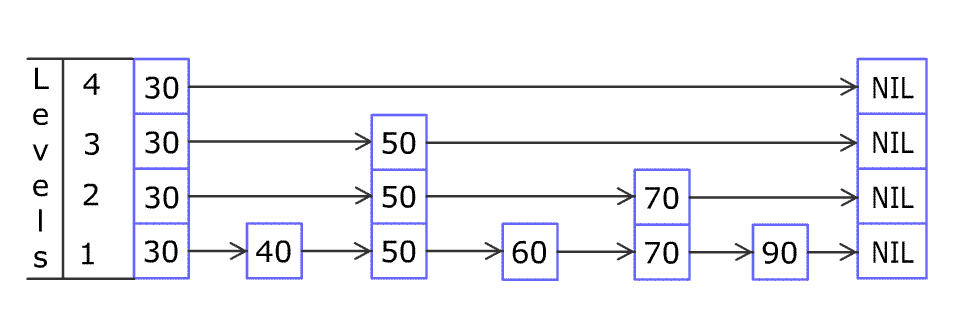- {x}
- Find Smallest Common Element in All Rows
- Minimum Time to Build Blocks
- Minimum Absolute Difference
- Ugly Number III
- Smallest String With Swaps
- Sort Items by Groups Respecting Dependencies
- Last Person to Fit in the Bus
- Monthly Transactions II
- Design Skiplist
- Unique Number of Occurrences
- Get Equal Substrings Within Budget
- Remove All Adjacent Duplicates in String II
- Minimum Moves to Reach Target with Rotations
- Queries Quality and Percentage
- Team Scores in Football Tournament
- Intersection of Three Sorted Arrays
- Two Sum BSTs
- Read More...

Design Skiplist
Design a Skiplist without using any built-in libraries.
A skiplist is a data structure that takes O(log(n)) time to add, erase and search. Comparing with treap and red-black tree which has the same function and performance, the code length of Skiplist can be comparatively short and the idea behind Skiplists is just simple linked lists.
For example, we have a Skiplist containing [30,40,50,60,70,90] and we want to add 80 and 45 into it. The Skiplist works this way:

Artyom Kalinin [CC BY-SA 3.0], via Wikimedia Commons
You can see there are many layers in the Skiplist. Each layer is a sorted linked list. With the help of the top layers, add, erase and search can be faster than O(n). It can be proven that the average time complexity for each operation is O(log(n)) and space complexity is O(n).
See more about Skiplist: https://en.wikipedia.org/wiki/Skip_list
Implement the Skiplist class:
Skiplist()Initializes the object of the skiplist.bool search(int target)Returnstrueif the integertargetexists in the Skiplist orfalseotherwise.void add(int num)Inserts the valuenuminto the SkipList.bool erase(int num)Removes the valuenumfrom the Skiplist and returnstrue. Ifnumdoes not exist in the Skiplist, do nothing and returnfalse. If there exist multiplenumvalues, removing any one of them is fine.
Note that duplicates may exist in the Skiplist, your code needs to handle this situation.
Example 1:
Input ["Skiplist", "add", "add", "add", "search", "add", "search", "erase", "erase", "search"] [[], [1], [2], [3], [0], [4], [1], [0], [1], [1]] Output [null, null, null, null, false, null, true, false, true, false] Explanation Skiplist skiplist = new Skiplist(); skiplist.add(1); skiplist.add(2); skiplist.add(3); skiplist.search(0); // return False skiplist.add(4); skiplist.search(1); // return True skiplist.erase(0); // return False, 0 is not in skiplist. skiplist.erase(1); // return True skiplist.search(1); // return False, 1 has already been erased.
Constraints:
0 <= num, target <= 2 * 104- At most
5 * 104calls will be made tosearch,add, anderase.
Solution Explanation for Design Skiplist
This problem requires designing a Skiplist data structure from scratch. A Skiplist is a probabilistic data structure that allows for efficient searching, insertion, and deletion of elements, with an average time complexity of O(log n) for each operation.
Core Concepts:
-
Levels: A Skiplist consists of multiple sorted linked lists layered on top of each other. The bottom-most layer contains all elements, while higher layers contain a progressively smaller subset of elements. This layered structure allows for faster search operations by skipping over large portions of the list.
-
Probabilistic Promotion: When inserting an element, its inclusion in higher layers is determined probabilistically. This ensures that, on average, the height of the Skiplist remains logarithmic with respect to the number of elements.
-
Node Structure: Each node in the Skiplist has a value and an array of pointers (
next), one for each level it participates in. The pointers point to the next node in that level's linked list.
Algorithm:
-
Skiplist(): The constructor initializes the Skiplist with a head node and sets the initial level to 0. -
search(target): This function iterates through the Skiplist levels from top to bottom. At each level, it finds the node with the largest value less than or equal to the target usingfindClosest(). If a node with the target value is found at any level, it returnstrue; otherwise, it returnsfalse. -
add(num): This function first determines the random level for the new node usingrandomLevel(). Then, it iterates through the levels from top to bottom. At each level, it finds the appropriate insertion point usingfindClosest()and inserts the new node into the list at that point. -
erase(num): This function iterates through the levels from top to bottom, removing any instances of thenumvalue from each level's linked list. If the number is not found, it returnsfalse. After removal, it adjusts thelevelto reflect the updated structure of the Skiplist. -
findClosest(curr, level, target): This helper function finds the node in a given level that has the largest value less than or equal to the target. -
randomLevel(): This helper function determines the random level of a new node based on the probabilityp. It simulates a geometric distribution.
Time Complexity Analysis:
-
search(target): O(log n) on average. The number of levels is logarithmic in the number of elements, and the search at each level takes constant time on average. -
add(num): O(log n) on average. Similar to searching, the number of levels and operations at each level are logarithmic. -
erase(num): O(log n) on average. The removal process has a similar time complexity to insertion.
Space Complexity Analysis: O(n) - The space used is proportional to the number of nodes in the Skiplist.
Code Examples (Python, Java, C++, Go):
The code examples provided in the original response demonstrate the implementation of the Skiplist class in four different programming languages (Python, Java, C++, Go). Each implementation follows the algorithm described above and includes the necessary helper functions. The choice of language depends on personal preference and project requirements. The core logic remains consistent across all languages.